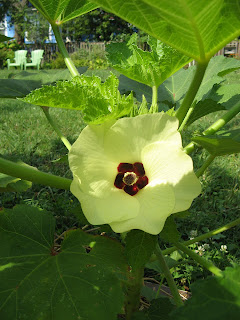My crop rotation has been less than disciplined. Though I'm now up to eight beds (seven in full sun), the rotation options are pretty limited in summer, when most of the desirable crops are related (cukes and squash; tomatoes, peppers, and eggplant). Those crops are also some of the most disease-prone, whether from soil-based fungal diseases (e.g., tomato blight), or insect-carried diseases like the bacteria spread by cucumber beetles.
Other than really fastidious efforts in the garden--i.e., care in watering and mulching, my only real option as an organic gardener is to solarize the soil. This process, covering the garden with black plastic to kill disease, is not really appealing, as it will probably kill beneficial organisms as well (though they do return quickly). It also takes up valuable real estate for at least four weeks. We'll see if things bounce back enough the rest of the summer for me to avoid that. Cooler temps, rain, better watering practices, and an addition of organic fertilizer might turn things around.
Inspired by a post on Chiot's Run on the use of mustard as a cover crop (it might suppress pathogens!), I've also been investigating cover crops to improve my soil structure. Even though my raised beds were filled with purchased topsoil and compost and soil test results have shown good nutrient levels, I was still dealing with a natural product with variation, and some beds have ended up with better soil than others. Healthy soil=healthier plants more resistant to disease. I always thought that cover crops would be problematic in raised beds, as they cannot be tilled under. It seems that is not the case, and I can just cut down the cover crops or let winter do the job. So, if the summer squash does not take a turn for the better soon, then I may sow a patch of buckwheat.
Here's a progress report on the summer crops:
Up:
Delicata squash (amazing!--they laugh off the squash vine borers, which I extract with a knife, though I did lose one younger vine)
Black Eyed Peas (late for some reason, but coming on strong on my new string trellis)
Eggplant (Listada de giandia) (looking good, one of the prettiest eggplant varieties)
... and many more to come--love those blooms!
Down:
Tomatoes (had to remove three that were diseased/not thriving; blossom drop from the heat a factor)
 |
| happy tomato |
 | ||
| sad tomato |
Summer squash (lemon squash) (these are wack--how is it that so many home gardeners have tons of summer squash to give away? These have performed poorly for me.)
Winter squash (buttercup) (ditto--blooms on inch-high plants?)
Maybe:
Cucumber (looking okay, but I dare not jinx myself with cukes)
Small Red Beans (too early to tell, but looking good--though some may have rust, Burned by "semi-bush" again though--these are starting to clamber over the peppers and eggplants.)
Hot Peppers (ditto--these may end up loaded with peppers late in season but have been inexplicably slow to set fruit)
Sweet Peppers (cautiously optimistic--pinching early blooms seems to have resulted in stronger plants better able to hold fruit. Maybe this will be my first year of success with sweet peppers!)
I forgot the tomatillos! Doing okay so far, these are strange in that they are growing out instead of up like in my previous experience with tomatillos.
Finally, I am experimenting with sweet potatoes in a cloth pot:
It can be defeating when the farmers' market is full of local produce, as are many home gardens in my area, but I've got to be patient and enjoy what I have.













No comments:
Post a Comment